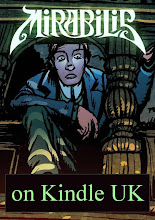“Will you draw me a picture?”
I know, I know - writing ain’t as sexy as drawing. But even though I always loved comics and was an absolute otaku when it came to the great Silver Age artists, the writing was what I set my heart on doing. (And listen, Richard Starkings always wanted to be a letterer, so I’m not that weird, okay?)
Most people think writing is just making up the words, but the words are the tiniest part of it. Before that, there’s coming up with the story. And when you have the story (which is the second tiniest part) you get to the real job, which is to make it entertaining.
Ninety percent of writing is pure instinct. You rarely have exactly the same problem to solve twice. That’s what makes it rewarding and very, very lonely. Graham Greene said that “a writer is one who knows the long despair of doing nothing well.” A bit of a tortured genius, our Graham, but he hit the nail on the head with that one. After twenty-five years of doing this for a living, I’m still flying by the seat of my pants.
Ten percent is craft, though, and that can be taught. Which is why, from time to time, I do these little posts on writing technique - just in case you’re in that almost-crazy zone between the guy who wants to be the artist (that’s lead guitar) and the freak who enjoys lettering (I guess he’s the drummer).
Okay, today’s writing tip is about the necessity of confounding expectations. What that means is that often you will set up the story so that it needs to go a certain way. And most of the time the reader will be there before you - not just because they’re smart (though they are) but also because you’ve planted all the signs properly. But here’s the rub. If the scene just goes the way you seem to want it to, the reader is going to kick against that. To enjoy the story, they’re having to suspend disbelief, and every predictable moment risks bringing disbelief right back into focus.
Let me give you a couple of examples of how it works. First from Vertigo:
Scotty (Jimmy Stewart) is waiting for Judy to return from her makeover. We expect him to go “Gosh!” the moment she shows up dressed as Madeleine, her hair now dyed blonde, wearing the gray suit he picked out for her, and so on - but something still isn’t quite right. It’s only after he gets her to pin her hair back just the right way that he can finally see her as Madeleine.And this one from The Last King of Scotland:
Dr Garrigan (James McAvoy) spins a globe and decides he will go wherever his finger lands. Of course, we know he’s going to Uganda. Only that's not where his finger lands. The first time he stops the globe at Canada, but immediately decides that won’t do. He wants adventure. He spins it a second time, and then he gets Uganda.These scenes both use a kind of narrative sleight of hand to overcome our natural resistance to being spoon-fed a story. While we are concentrating on what we expect to happen, we are not expending our scepticism on any other outcome. So when the scene plays, as it were, out of the magician’s other hand, we are surprised into full acceptance.
Right, so now you can do it at home for fun and profit. Well, for fun anyway.

























No comments:
Post a Comment